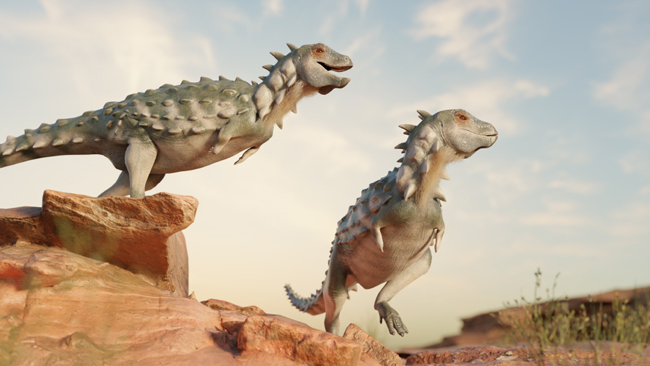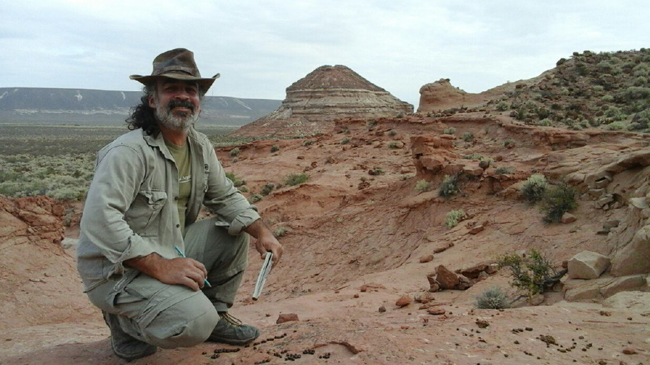A Very Strange Armoured Dinosaur from South America
Researchers have announced the discovery of a new species of Late Cretaceous armoured dinosaur from fragmentary fossils found in North Patagonia, (Río Negro Province, Argentina). It may represent an entirely new and previously unknown branch of the armoured dinosaur family tree from South America (Gondwana). Named Jakapil kaniukura (pronounced Jack-a-pil can-nee-ook-your-rah), it is the first definitive thyreophoran species from the Patagonia of Argentina and it might have been a biped with short, stumpy arms reminiscent of the abelisaurid theropod dinosaurs.

Fossils from the “La Buitrera Paleontological Area” (LBPA)
Writing in the academic journal “Scientific Reports”, researchers from the Universidad Maimónides (Buenos Aires, Argentina) in collaboration with a colleague from the Universidad del País Vasco/Euskal Herriko Unibertsitatea (Bilbao, Spain), report the discovery of a fragmentary, disarticulated skeleton representing a sub-adult animal, from the upper beds of the Candeleros Formation (early Late Cretaceous 94-97 million years ago). The sandstone exposures represent aeolian (wind borne) sand dunes indicating an arid to semi-arid palaeoenvironment in what is now termed the “La Buitrera Paleontological Area” (LBPA). The holotype (MPCA-PV-371), consists of skull elements including bones from the jaw, rib fragments, bones from the shoulders, two partial upper arm bones (humeri), a possible partial right ulna and other assorted fragmentary limb bones. Fifteen partial teeth were also recovered along with numerous osteoderms (dermal armour).

The sub-adult animal is estimated to have had a body length of less than 1.5 metres, perhaps weighing around 4.5 to 7 kilograms.
Commenting on the significance of this fossil discovery, lead author of the paper Facundo Riguetti (Universidad Maimónides), stated:
“Our finding is important for several reasons. On the one hand, Jakapil expands the fossil record known in the region and allows us to know a little better the prehistoric ecosystem of our land, and specifically of the ancient Kokorkom desert, today northern Patagonia.”

The PhD student went onto add:
“Moreover, this new species represents a lineage of thyreophoran dinosaurs previously unknown in South America. The Thyreophora originated about two hundred million years ago and evolved rapidly into several species distributed throughout the world. However, of these early thyreophorans, the lineage represented by Jakapil was the only one that persisted until at least a hundred million years ago.”
A Survivor from an Ancient Armoured Dinosaur Line
Phylogenetic analysis recovers Jakapil kaniukura either as a basal member of the Thyreophora or a stem ankylosaur, closely related to Scelidosaurus, fossils of which are associated with the Lower Jurassic Charmouth Mudstone Formation of Dorset, England. Its discovery suggests that early thyreophorans had a much broader geographic distribution than previously thought and that an ancient lineage persisted into the early Late Cretaceous.

A Bipedal Armoured Dinosaur
Evolutionary trends observed in armoured dinosaurs suggest a transition between small, cursorial, light-weight species to much larger, heavily armoured quadrupedal forms epitomised by the likes of Stegosaurus in the Late Jurassic and Ankylosaurus and Edmontonia in the Late Cretaceous. The relative dimensions of the forelimb and hind limb bear a greater resemblance to those of bipedal theropods and basal ornithischian dinosaurs than they do to members of the Thyreophora.
The reduced nature of the upper arm, indicated by the fragmentary humeri resembles the arm bones of abelisaurids – famous for their tiny, almost vestigial front limbs.

Etymology
The genus name is from the northern Tehuelchean language meaning “shield bearer”, whilst the species name is derived from the Mapudungun language for “crest” (kaniu) and “stone” (kura) which references the diagnostic bony crest on the lower jaw.

The researchers, including co-author Sebastián Apesteguía (Universidad Maimónides) speculate that Jakapil, if it was a biped, resembled Scutellosaurus, which is known from the Early Jurassic of Arizona. However, they caution against defining this little armoured dinosaur as bipedal. They observe that it still retains some anatomical characteristics associated with a quadrupedal stance and they comment that more complete limb bones are required to make a more accurate assessment of its locomotion.
Everything Dinosaur acknowledges the assistance of a media release from the Consejo Nacional de Investigaciones Científicas y Técnicas (CONICET) in the compilation of this article.
The scientific paper: “A new Cretaceous thyreophoran from Patagonia supports a South American lineage of armoured dinosaurs” by Facundo J. Riguetti, Sebastián Apesteguía and Xabier Pereda-Suberbiola published in Scientific Reports.

